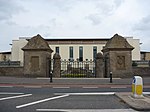Penicuik Athletic F.C.
1888 establishments in ScotlandAssociation football clubs established in 1888East of Scotland Football League teamsFootball clubs in ScotlandFootball in Midlothian ... and 4 more
PenicuikPenicuik Athletic F.C.Scottish Junior Football Association clubsUse British English from May 2015
Penicuik Athletic Football Club are a Scottish football club. They were formed in 1888 and are based at Penicuik Park, in the town of Penicuik. Penicuik Park is ten miles south west of Edinburgh on the A702 road. The team now plays in the East of Scotland Football League Premier Division, having moved from the junior leagues in 2018.
Excerpt from the Wikipedia article Penicuik Athletic F.C. (License: CC BY-SA 3.0, Authors).Penicuik Athletic F.C.
John Street Lane,
Geographical coordinates (GPS) Address External links Nearby Places Show on map
Geographical coordinates (GPS)
| Latitude | Longitude |
|---|---|
| N 55.830348 ° | E -3.22556 ° |
Address
Penicuik Athletic F.C.
John Street Lane
EH26 8NQ , Broomhill
Scotland, United Kingdom
Open on Google Maps






